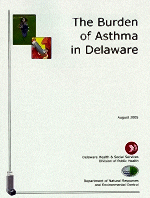Report Details Asthma Prevalence And Burden in Delaware

About 46,000 adult Delawareans are estimated to have asthma; and as many 72,000 have had asthma at some time during their lives. A new report on asthma in Delaware estimates that total direct charges for asthma-related health care could be between $25 and $30 million a year.
This information is published in a report, The Burden of Asthma in Delaware, which was released in October 2005 by the Division of Public Health, and the Delaware Department of Natural Resources and Environmental Control. The report and a “Report Highlights” fact sheet can be downloaded below:
- The Burden of Asthma in Delaware Report PDF File | Report Text File
- Report Highlights (printable for distribution) Highlights PDF File | Highlights Text File
Among the report’s highlights:
In 2003, 11.7% of Delaware adults (about 72,000) reported having asthma at some time during their lives, according to the Delaware Behavioral Risk Factor Survey. About 7.5% (or 46,000 adults) currently have asthma.
Delaware’s prevalence is the same as the national prevalence for 2003.
Asthma appears to be slightly more prevalent among young people. In the Delaware Youth Risk Behavior Survey for 2003, about 19% of high school students reported having been diagnosed with asthma; and 6.5% said they had an asthma attack in the past 12 months.
Delaware’s asthma-related hospital discharge rate in general is comparable to the national rate.
Children under age 4 are more than twice as likely to be hospitalized with asthma than any other age group. They are about 4 times as likely to have an asthma-related hospitalization than adults. The report estimates about 3,000 asthma-related hospitalizations of young children a year.
In Delaware, African American residents are hospitalized because of asthma at rates nearly three times greater than whites. Neither the lifetime nor the current prevalence rates have such a high level of disparity.
There is no central registry of emergency room data, so the report examines data from two insurance plans—state employees and Medicaid. Medicaid members are almost three times as likely to use emergency room services for asthma treatment.
In 2000 and 2001, the most recent years for which data are available, there were 17 deaths per year from asthma in Delaware.
Economic Issues
Charges to Medicaid for asthma medications more than doubled, from $4.4 million in 2000 to $9.7 million in 2003. Total asthma-related Medicaid charges in 2003 were $13.9 million.
Total asthma-related claims from the state employee plan in 2003 were $2.6 million.
Total statewide charges for asthma treatment and medications could be as high as $25 to $30 million a year.
Asthma also affects productivity and quality of life. According to the Delaware Behavioral Risk Factor Survey, about 23% of adults with asthma were unable to work or carry out daily activities for one or more days during the past month.
Environmental Factors
Smoking and airborne pollution are major triggers for asthma symptoms.
Eight years of evidence-based, comprehensive tobacco prevention and education programs in the state have resulted in significant reductions in cigarette smoking in our state. Prevalence of regular smoking among high school students—those who smoke on at least 20 days of every month—decreased from 15% in 2000 to 9% in 2004, according to the Delaware Youth Tobacco Survey. The state’s strong Clean Indoor Act is also protecting people with asthma from exposure to second-hand tobacco smoke in public places.
The Department of Natural Resources and Environmental Control (DNREC) monitors six air pollutants, and produces an Air Quality Index (AQI), which is available on the DNREC website. The report shows the number of days the AQI is rated unhealthy for sensitive individuals. New Castle County has the most days categorized as unhealthy. New Castle County has had more than 15 days classified as unhealthy in ten of the last 11 years. In contrast, Sussex County had less than 15 unhealthy AQI days in eight of 11 years, and Kent County has had more than 15 unhealthy AQI days only once (in 1998).
DNREC also monitors pollutants called Fine Particulate Matter, which are dangerous because they can penetrate more deeply into the lungs than large particles. Delaware has not been able to comply with the National Ambient Air Quality Standards for Fine Particulate Matter, because New Castle County’s yearly average pollution level is greater than the standard.
For both ozone and Fine Particulate Matter, New Castle County has the highest air pollution levels, while Kent County has the lowest air pollution levels.
A free copy of Adobe Acrobat Reader can be downloaded directly from Adobe. If you are using an assistive technology unable to read Adobe .pdf, visit Adobe’s Accessibility Tools page.



